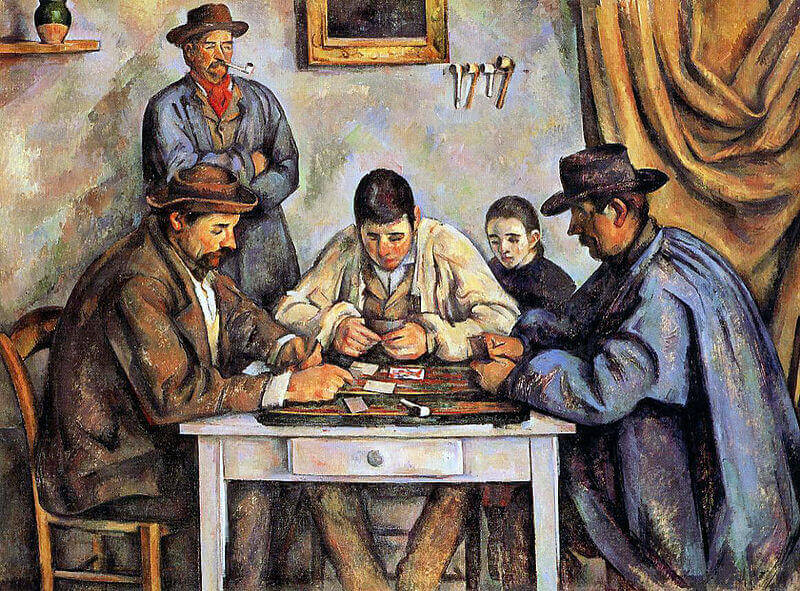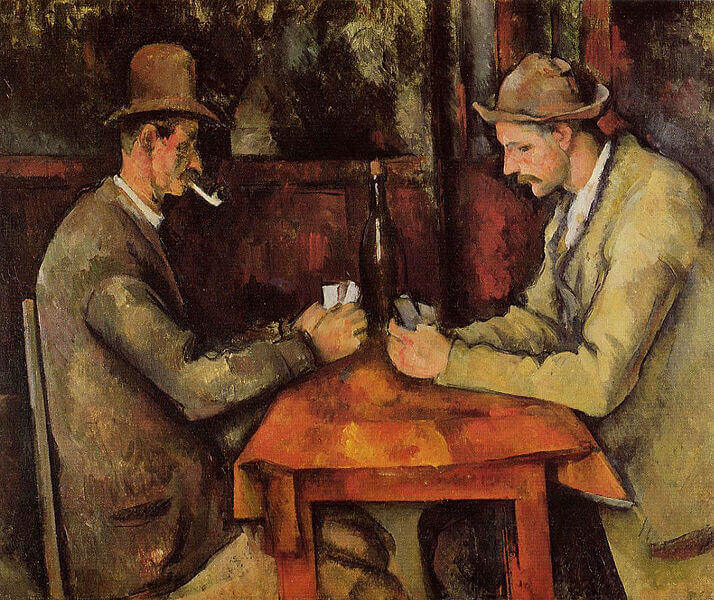There are five paintings in The Card Players series, painted by French Post-Impressionist artist Paul Cézanne in the early to mid-1890s. The different paintings all vary in size, as well as the number of players depicted and the setting in which the game is taking place. In preparation for the painting of these images, Cézanne did many drawings of his concepts. Although there are five paintings that were completed, the last three were so similar in their composition, with each featuring two players, that they are often grouped together as one version of The Card Players. There are no dates on the paintings making their exact creation years uncertain, but many believe that Cézanne started with the bigger paintings and worked his way to the smaller ones last. In 2011, the royal family of Qatar bought a version of The Card Players for an estimated $300 million, making it the third most expensive piece of art ever sold.
The Card Players 1890 – 1892

The Card Players painted between the years 1890 – 1892 is the largest of the five paintings, and is the most complex. Painted on a 53 x 71 inch canvas, this painting features three card players at the forefront of the painting, all seated in a semi-circle at a small table with a drawer, and two spectators behind. The spectator on the right hand side of the painting is a boy with his eyes cast downwards, who is seen sitting behind the second man, on the right of the third man, and is spectating the game. On the left side of the painting, located further back is standing between the first and second man, with his back against the wall as he smokes a pipe. It is assumed that he is awaiting his turn to play. Many have guessed that the standing man was added to the scene to provide depth and to draw the viewer’s eye to the upper part of the painting.
The Card Players 1894 – 1895

In the last three paintings of The Card Players, Cézanne removed the spectators and other details that he deemed unnecessary in order to show just the absolute fundamentals, which comprised of two card players absorbed in their game. The smallest of the paintings, created around the years 1894 – 1895 is painted on a 17.75 x 22.5 inch canvas, and although it is asymmetrical, it is considered to be a well-balanced picture. The man on the left is wearing a down cast brim top hat with darker, more formal clothes, sitting upright with a pipe in his mouth. The man on the right is wearing a shorter up cast brim hat with lighter, more casual clothes, sitting in a more hunched position without a pipe. Not only the players but the cards are contrasted, with the man in the dark clothing holding light cards, and the man in the light outfit holding dark cards. A single bottle of wine is seen in the middle of the table in all of the two player paintings, and is thought to represent a dividing line between the players, and the center of the paintings balance.
Dogs Playing Poker
Comprised of a total of 18 paintings, the Dogs Playing Poker collection is made up of an 1894 painting, a series of sixteen oil paintings, and a painting by Cassius Marcellus Coolidge done is 1910. The sixteen oil paintings were commissioned by Brown & Bigelow to be used as cigar advertisements. All eighteen of the paintings show humanized dogs of different breeds, however, the eleven paintings in which the dogs are seated around a card table are the most well-known, especially in the United States, and are considered the prime example of what home décor can be found in working-class homes. One of the most popular and well-known Dogs Playing Poker picture is the first painting, Coolidge’s 1894 Poker Game, which depicts four Saint Bernard dogs seated at a round table with a green tablecloth. The picture sold in New York in November 2015 for $658,000.



